Video
vimeo
WATERS RUN DEEP
Kinetic Sound Sculpture
Medium: Transparent Polyethylene Bottle, Paint Tray & Brush, Parts of Two Electric Whisks, DC Motor, Water Level Switch, Relays, DIY Piezo Ceramic Hydrophone, DIN15 Cable, Computer Running Ableton Live, Paint Buckets, 2-way Auto Speakers, Amplifier
Waters Run Deep expands on the paradox of maintaining constant financial growth, all the while being faced with a univocal sign from nature that our consumption habits drastically need to change. In our efforts to acknowledge the possibility of an impending apocalypse, while not wanting to give up our hard earned mobility and lifestyles, we tend to end up treading water, acting half heartedly, too late, too little and then too desperate and overruled, while still fuelling the same vicious spiral.

Ehlin’s kinetic sound sculpture keeps itself running in a perpetuum mobile fashion, repeatedly reacting to its own whisking up of the water level inside a plastic bottle, only to turn itself off and go the other direction with the same result. A thin string of sugar trickles down from the ceiling and gets collected and distributed to the bottle via a rotating plastic straw through a static syringe.
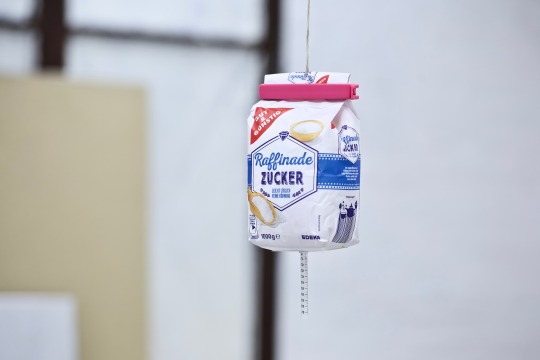
Due to them hardly ever lining up most of it ends up scattered across the paint tray and the floor. Given enough time, the sugar making it through the syringe will slowly change the viscosity of the water in the bottle and eventually turn it into syrup, thus bring the sculpture’s repeated bidirectional movement to a fail. The sound from within the bottle is amplified and played back by scavenged car speakers mounted inside two empty buckets for outdoor weather protection paint, giving a resonant quality not unlike that of holding a big seashell over one’s ear. The plastic bottle is of the Swedish brand T-Röd (”T Red”), an alcohol solution coloured unmistakingly red to avoid accidental misuse, and used as defroster, cleaner, degreaser and paint thinner. Its iconic design has remained unchanged over the last 50 years and can still be found in any gas station, super market, workshop or household.

Waters Run Deep shines a light on a hopeless binary scenario by playful use of symbolic values of the plain and the mundane. Traditionally opposing colours red and blue are used throughout to symbol hot and cold, plus and minus, left and right, before and after. In an increasingly partisan world, the political debate has gotten reduced to polarised jargon, when we more than ever need bipartisan solutions lasting longer than an election cycle.
3 notes
·
View notes
Video
vimeo
TAPE RIOT
Site Responsive Sound Sculpting For Performance In Urban Space
Choreography: Anna Anderegg
Dancers: Adaya Berkovich, Laureline Richard
Sound Artist: Anders Ehlin
Tape Artist: Hervé Thiot
Tape Riot is a site specific performative intervention that merges with and challenges the structure and rhythm of a city. It consists of two dancers, a tape artist and a sound artist, and moves through both indoor and outdoor urban spaces, sometimes several times during a single performance.
vimeo

Anders Ehlin’s sound work for Tape Riot takes off from the virtual spatial premise created by tape artist Hervé Thiot. It re-imagines the sonic outlines of an entire city as well as its single parts at once, just like Thiot’s geometrical tape structures create temporary architectural trompe l'œil skylines on top of the existing buildings.
Wireless satellite speakers housed in trash, cardboard boxes or found objects, provide multichannel audio at times, immersing the often unassuming audience in surround sound. The satellites are planted pre performance or by in-audience crew, enabling a platform for playful mixing of realtime on-location recordings and electronic improvisation.
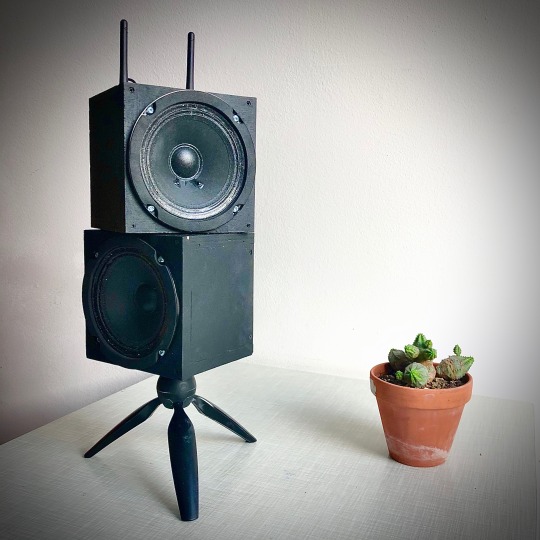
The sound work and spatialisation is made using an iPad with a selection of sound design and music production applications. During the performance the audience can fully submerge not only into a multidimensional visual experience, but also an augmented sonic and musical representation of the sounds that constitute the city. The sound improvisation utilises the reflections and reverberations from streets and buildings, constantly changing as the performance moves through the city landscape. It interjects itself between the dancers, the tape artwork, the audience and the surroundings, fluidly overlapping the space between improvised music, sound art and field recording practice.
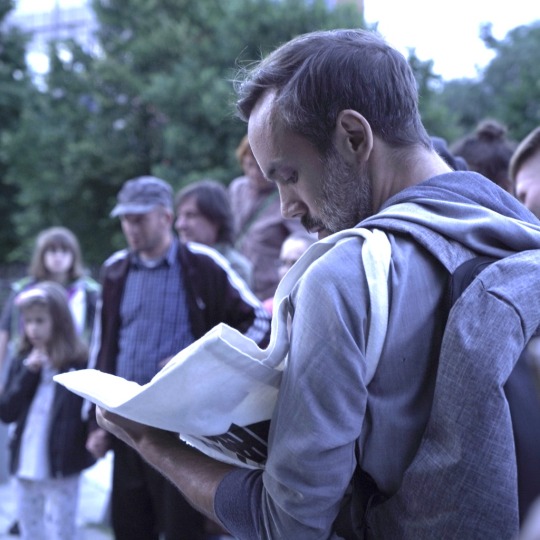
Tape Riot questions and explores 3-dimensional urban space by constantly moving improvisation, driven by a push/pull dynamic between all its performing parts. It invites passers-by to follow or simply cross paths. Interacting with this never still-standing performance, the audience continually has to change positions, thereby redefining the urban space they often take for granted, together with the artists.
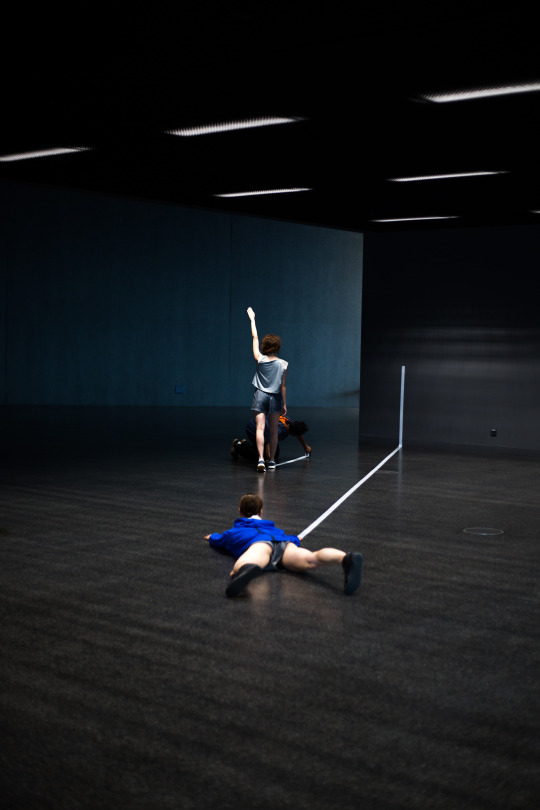
1 note
·
View note
Video
vimeo
WEGE DES HELDEN - SIEGFRIED.
Dir: Donald Berkenhoff
Prod: Stadttheater Ingolstadt, 2019
Prod: Stadttheater Ingolstadt
Credit: Composer, Musical Direction
Performed by: Anders Ehlin & Jakob Dinkelacker
Instrumentation, material:
Digitally Prepared Piano, Percussion, Transient and pitch Sensitive Triggers, FM Synthesisers, Drum Machines, Loop Pedal, Metal Plates equipped with Transducers, Vocals, Computer running Ableton Live.
https://soundcloud.com/hectordeguerre/siegfried-prologue
https://soundcloud.com/hectordeguerre/siegfried-sgfr-kriemhild-duel
https://soundcloud.com/hectordeguerre/siegfried-es-hilft-nicht-wir-brauchen-eine-list
https://soundcloud.com/hectordeguerre/siegfried-epilogue
Donald Berkenhoff’s interpretation of the Icelandic Edda tales, predominantly made famous through Richard Wagner’s Der Ring des Nibelungen, brings the different iterations of the tales together in both a humorist and stern way. It brings into play traditional Christian questions around vanity, egocentrism, altruism and shortsightedness, combined with current socio-political shifts and gender inequality, not the least through the undeniable brutal rape of the valkyrie Brunhild at the peak of the story. The musical direction of the piece had to balance a spectrum of wishes from the director, reaching from cabaret to dadaism, Northern archaic folklore, the omnipotent presence of Wagner, as well as uninhibited cinematic drama and action.

Berkenhoff integrated the instruments, the musicians and the musical performance centrally into the stage plot already in the script writing stage, providing a physical meta layer reminding the audience that theatre is a narrative construction, thereby challenging but paradoxically also strengthening the immersive aspects of the whole performance. A grand piano and a battery of drums were installed on two mobile podiums, which were moved into different locations on stage depending on the stage topological needs and the stage’s current position and angle.
Renate Knollmann, playing the Icelandic goddess Freya, had sung entries in the script already at conception stage. With these as a starting point the leitmotif of the play was composed, utilising the vocal technique of Swedish cattle calls (Kulning) with lyrics picked from Swedish medieval ballads based on the same Icelandic lore, and composed with a similar modal harmony over a pedal note, often heard in old nordic musical traditions.

Utilising a collection of scrap and found metal objects, long passages were rather composed for two improvising percussionists in call response fashion (rather than the more standardised piano/drums melody/rhythm configuration), where the piano body acted as resonating board or drum, played with mallets. Equipped with contact microphones it also served as a trigger board for amplitude and pitch responsive FM Synthesis, providing a parallel layer to the acoustic framework. Different ideas around resonance were a returning topic, between the actors, between the musicians and the actors, and within the different iterations of the Siegfried saga and its modern implications. For the purpose of underlining these parallel contextual feedback systems, two 2-meter tall resonating metal plates were constructed as secondary speaker sources for specific comments and sound textures, immersing the audience in a parallel horizontal plane of metallic sounding audio next to the theatre PA system.

Written about the music:
’All these images, combined with the live music, develop a pull that is hard to resist. Swedish composer Anders Ehlin has developed some electroacoustic trickery producing throbbing, pulsating, rattling, enervating soundscapes, experimental and monumental, archaic songs and wafting, blown past echoes from bygone dreams. And together with Jakob Dinkelacker on drums, he creates a mystical atmosphere on the grand piano.’ #Donaukurir
’…however, quite amazing is the simply breathtaking new tonalism by the on-stage integrated musicians Anders Ehlin (piano) and Jakob Dinkelacker (drums)’ #Augsburger Algemeine
1 note
·
View note
Audio
DEGRADATION IS JUST A/VERSION OF CHANGE
Composition for Wavefield Synthesis
Medium: 1 Blüthner Parlour Grand, 1 Östlind & Ahlmquist Upright, Transducers, Various Microphones, Ableton Live and Max MSP
Degradation Is A/Version Of Change deals with cyclic resonance and the inherent loss of information and accuracy occurring as a result of repetition and habituation. Life tends to be cyclical rather than linear, memories tend to get filtered and re-curated on an ongoing basis by the proximity of other memories and events, by our daily state of mind, by preferences regarding persons, places. Thus our history could indeed be seen as a floating narrative, never more accurate than the point of view from which it is told from. This is something that has been widely acknowledged in paradigm based studies of history and sociology during the past 3 decades. Both past, present and future events constantly resonate with each other, our partaking is based both on how we have lived through, are currently living through, and how we think we will live through certain encounters, thereby making a row of events seemingly happening in a consecutive linear order, non-separable and interconnected by nature. Rather they are being filters, triggers, agents to each other in an ongoing cause effect chain that we will probably never be able to properly overview. This ongoing resonance and volatility has been the artist’s main motivation and focus point when conceptualising the piece.

The two pianos being the two sole sound sources of the composition are of particular emotional value for the Artist, and their co-existence and connection to the topic one of the main reasons for being the main feature of the composition. They are the two main instruments he grew up and learned to play the piano with back in Sweden, thus they constitute they very raison d’être of the Artist’s musical and artistic life. Fittingly they have also both been featured on several albums and productions by the Artist throughout his adolescence and 20s.

The pianos were recorded separately in their respective locations. Albeit not in their original locations in Sweden anymore, their different locations are still reflecting on the fact that they are from different periods and areas of the Artist’s life. Thus, on a poetic level this piece aims to juxtapose these two instruments and their respective sound, in their own right, but also as allegories over how the different periods in one’s life intersect with each other. How certain decisions, certain periods resonate into the present for years to come, while others literally get rejected into the peripheral, sometimes only to end up in the foreground much later in one’s life.
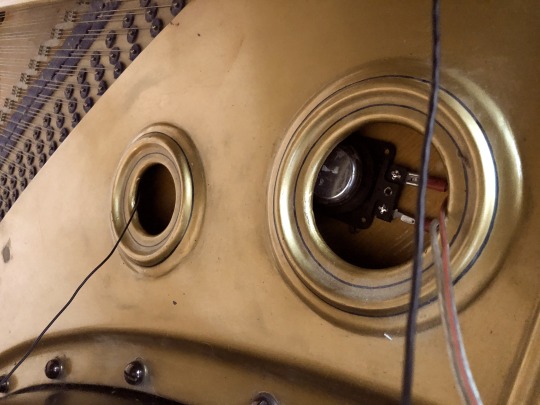
To illustrate this the artist continued his current research on transducer and contact microphone induced structural resonance and feedback. This by having the recording of one piano being played back and resonating through the frame and body of the other, after which the new recording would be run through the first one again and so forth, in an ongoing ping pong fashion, producing a cyclic degradation and coloration of the original material where in the end the only thing that remains is the multiplied and accumulated sound of the two pianos’s bodies and specific resonances.

As the pianos are placed in different locations, and with limited access to the Blüthner Grand, convolution impulse responses from both the pianos were meticulously created in order to facilitate for this feedback loop digitally rather than manually. Convolution technique is also used in a more creative fashion in the piece using parts of the main musical material as impulse response rather than to achieve a certain room characteristic (see overview below).
0 notes
Video
vimeo
THE FREEDOM OF CHOICE
Sound Installation
Material: Site Specific Wooden Structure
4ch Audio, Mirrors Amplified With Transducers,
Microphones, Tape Deck, Relays, Arduino Computer, Questionaire
Freedom... how strange today in our society, [how] the scope of what is possible and what is impossible is distributed. [...] The intelligent dialectic of freedom is that systems [are] presenting us with a whole scope of formal freedoms, but the tricky thing is to see how many of these freedoms are empty freedoms, in the sense that formally you can do it, but really, the stability of the entire system is grounded in the idea that, really, you can not do it.
- Slavoj Zizek, interviewed by Owen Jones for the Guardian, Oct 24 2018 (Youtube)
We are surrounded by what appears to be a constant stream of choices, most of them unimportant and of no influence in the grand scope of things. Still, choices make us feel included, interactive, free and independent – therefore choices are sold at a premium. But how much of a choice are actually the choices we are given rather than being pre-curated internal/discrete structures aimed to keep us from interfering with the important events in the world? And to what degree are we accomplices in this, our own confinement, when we actually keep allowing it to prevail?
The Freedom of Choice aims at questioning the fundaments on which we build our assessments, starting from the idea that choices and interactivity indeed cross-feed each other. Interactivity happens actively in our heads, not only towards an external agent. By assessing an experience towards earlier ones we verify and categorize it, thereby we actively filter incoming stimuli, so that we continuously can build coherent cause/effect chains of events and leave brain resources for new incoming tasks. But what lies behind these assessments, how do preconditioned connotations steer our judgement towards surrounding events? The plethora of choices and options often appear to exist primarily to boost and further resonate our self image and status, but evaporate like chimeras when put into context of the actual world around us.
Thus, The Freedom Of Choice works along 3 overlapping concepts; the floating idea of free choice just described, humans’ inherent wish need to interact with the world around us, and the concept of resonance as both a necessary fundament for, and most often also the result of, interaction. By staging a row of seemingly random props and events, the visitor is invited to explore a space both claustrophobic and infinite, but where the infinity rather than stretching outwards, only is a multiplication of ourselves. Thereby it mirrors how the choices we are presented with often are tailored to reflect and augment our lives and our lifestyles. It wants to raise the question: are any of the things and events presented to us actually connected, or purely coincidental. And most of all, in this never ending augmented self-reflection, are you at all a part of it?
0 notes
Photo
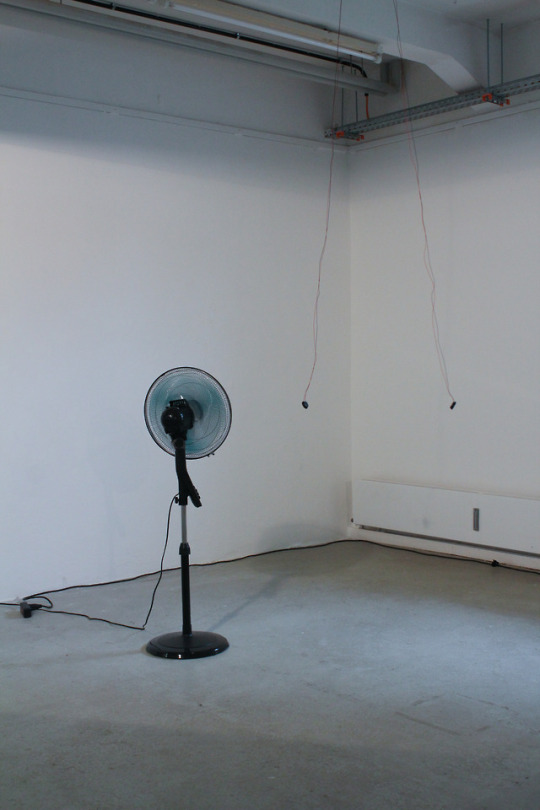
FIRE AT WILL
Sound Sculpture
Medium: Piezo Cheramic Elements, Speaker Cable, Pidestal Fan
Part of Group Exhibition "Und also sprach das Internet: Du sollst dir ein Bildnis machen“
Gallery: Haus 10, Fürstenfeldbruck, Munich
vimeo
Fire At Will conceptually takes over from the overall framework set by Åsiktskorridor, by portraying the polarized nature of the growing partisanship seen across the world's political stage, that seem destined to sow divide and/or dumb down the general debate. Two small piezo speakers hung from the ceiling are put in swinging motion in tandem by a pedestal fan slowly panning left to right. Its constantly changing blowing direction ensures the speakers to always swing out of unison, still stay in parallel motion and never actually crash into each other. All the while the Lee and Karen iterations of Apple's TTS-engine Siri laconically utters the word “Bang” on random occasions through each of them respectively. Like the political debate they portray, they do give us a faux feeling of interacting with each other, their movements seeming synchronized albeit reversed, kept in perpetual inverted motion by how the wind of opinion change, all the while shooting randomly against each other from their respective trenches, without actually getting much said.


0 notes
Video
vimeo
ASIKTSKORRIDOR
Site Specific Sound Installation
Medium: Corridor with microphone, 4 Channel Audio
Part of Group Exhibition “Und also sprach das Internet: Du sollst dir ein Bildnis machen“
Gallery: Haus 10, Fürstenfeldbruck, Munich

By digitally fragmentizing live radio broadcasts across the different speakers positioned across the rooms, Åsiktskorridor tries to create a locally contained warped information collage, giving the notion of information, but essentially never allowing us to fully grasp the full picture. In a corridor a microphone is installed that in periods or fragments, or when fed with a signal loud enough, will interfere with the fragmented broadcast, essentially giving the visitors a possibility to get their own voices heard, i.e air their opinions, within the local audio network. But because of the fragmented nature of the algorithm, you will never know, if at all, or what part of what you say will be picked up and redistributed. You are in other words always at the risk of being misinterpreted, misquoted, misunderstood, or simply ignored. By this, the installation wants to challenge our awareness of real life vocal participation vs for example stating one's opinions through an online avatar, thereby working actively with the exhibition's overall topic of proxies. How big is the step to say something that potentially will be distributed through the loudspeakers across the gallery, compared to commenting to a post on social media? How big is the personality gap between the real us and our avatar representations?

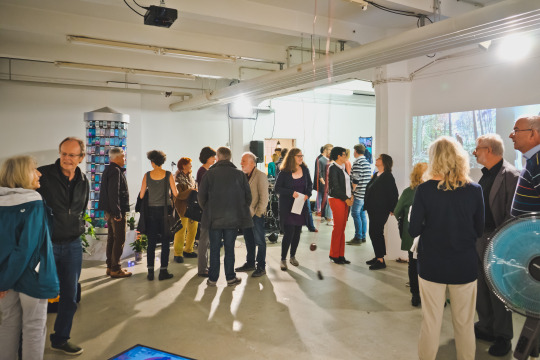
0 notes
Video
vimeo
BEND TO MY WILL
Sound Sculpture
Medium: Etched Copper Plate, Linear Actuators, Steel Foot, Arduino, Contact Microphone, Transducers.
”Nor again is there anyone who loves or pursues or desires to obtain pain of itself, because it is pain, but because occasionally circumstances occur in which toil and pain can procure him some great pleasure.” - Cicero
Bend To My Will portrays the shortsightedness and opportunism that constitute much of the current communicative discourse. Ideologies are increasingly being replaced by volatile pseudo standpoints, arguments are being substituted by catch phrases, juxtaposed monologues are staged as proxies for dialogue. An increasing fear of ambiguity caters for reactive bursts of resonances within a growing number of echo chambers across the political spectrum, as people look for belonging and cohesion.
In Bend To My Will, Ehlin controls and manipulates an ongoing electro-acoustic feedback loop by continuously changing the bent shape of a 2 meter tall copper plate. As the shape changes, so does the plate’s inherent resonant frequency, thereby breaking each resonance build-up so that it has to start over again from its new fundamental frequency. In a perpetuum mobile fashion the plate reflexively changes shape every time the feedback gets too loud, literally making it shy away every time the resonance crosses a certain threshold.
The engraving Lorem Ipsum… is a scrambled version of texts by Cicero on the topic of hedonism, opportunism and shortsightedness. Mostly without any reference to its original meaning the text has been the default exemplary text used in printing, along with copper, the original material of early printing technology. Through the continuous changing of resonant frequencies, the audience is invited to experience the shift between moments of ambiguity and peaks of howling clarity. Can we in days of echo chambers and filter bubbles afford to trust resounding resonance or do we need to learn to find acceptance and fulfilment within the ambiguous and opaque?
0 notes
Photo

BREATH. PAUSE. BLACK.
Sound Sculpture
Medium: 8-Channel Audio, wooden frame
Part of Group Exhibition “Horror Vacui” together with Lucas Guitierrez and Protey Themen
Gallery: Aperto Raum, part of Transmediale-Vorspiel February 2018.
vimeo
Starting with the sound of his own breath as source material, the artist uses data from the 3D-scanning of Lucas Guitierrez’s “A\/B” to modulate his soundscape to Breath. Pause. Black. By juxtaposing and phase shifting granulated and fragmented layers of his own breathing, Anders paints a sonified but blind folded version of the gallery.
Breath is the absence and the anticipation of the voice, the starting point and the pause. It’s the physical filling of our bodily void, and likewise its emptying. Cyclic balance and interruption intertwined, in order to sustain life.


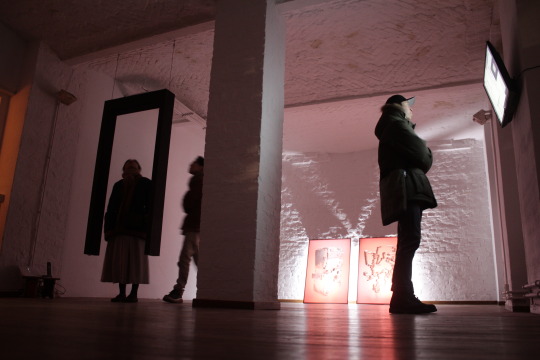

0 notes
Video
vimeo
LIMINALS
Medium: 4k Video, 5.1 Sound
Director: Jeremy Shaw
Production: Johan König Galerie, Berlin
Language Manipulation & Sound Design: Anders Ehlin
Sound Design & Music: Todd Shillington
Premiere: Venice Biennale/Arsenale, Venice, May 2017
Video Installation by Jeremy Shaw.
Set approximately 50 years from today, LIMINALS plays like a single chapter cut from a future documentary flm about marginalized societies. As the world and human species are on their last legs, failing in heath and reliant on virtual reality for any type of transcendental behavior, small clandestine groups have taken it upon themselves to search for possible ways of inciting evolutionary advancement in an efort to potentially save the species. One such group are the Liminals, who believe that by augmenting the brain with Machine DNA and re- engaging in long-abandoned cathartic religious rituals, they will be able to access a para-space where reality is altered in between the physical and the virtual. It is here that they believe humanity can temporarily exist while evolving into its next phase.
LIMINALS is set against a cinema verite aesthetic that appears to repurpose archival footage of a 1970’s experimental dance group, or possible cult, to tell it’s story. Narrated by a hypnotic, BBC-like voice and employing black and white 16mm film, the piece follows 8 dancers through their engagement in varying cathartic ritualistic behaviors. These scenes, interviews and narration will eventually build into a heightened abstract climax in which the speculative para- space is achieved and illustrated via a drastic shift in medium and aesthetic – segueing from the outmoded 16mm to contemporary digital VFX that aim to serve as both the visualization of the subjects transcendental unification while inciting a phenomenological response from the viewer themselves.
0 notes
Video
vimeo
DELPHI RATIONALE
Medium: 4k Video, 5.1 Sound, 1 Guitar Amp
Director: Philipp Lachenmann
Production: Medienboard Berlin
Sound Composition & Conceptualization: Anders Ehlin
Animation: Stephan Stubbe
Exhibited at ACE Gallery Los Angeles, Oct 4-Dec 16.
Premiered as work-in-progress at Galerie Andreas Binder, Munich 2017
Video work by Philipp Lachenmann presented as a part of his touring exhibition DELPHI. Involving the Indian sarod player Ranajit Sengupta and an elaborate postproduction, CERN‘s DELPHI detector in Geneva, as the “temple of cutting edge discoveries and expanding knowledge”, is turned into the mise-en-scène for a paradoxical mystery. By subverting the physical functions and scientifc tasks of the detector, DELPHI Rationale delves into the interstice of objectivity, and infuses the mathematical world of cause & effect with layers of irrationality, wonder, and aesthetics. In its wake, color as a matter of dramaturgy leads to Painting Reloaded.
0 notes
Video
vimeo
THE GRACE CHAPTERS
Medium: 2k video shot in 3D, 2ch sound.
Director, Editor: Lene Vollhardt.
Dramaturgical Consultation: Anders Ehlin.
Music & Sound Design: Anders Ehlin
Award for ”Best Experimental Film”, Hong Kong Art House Film Festival 2017
The ”Grace Chapters” is an experimental adaption of Grace Kelly ́s Life, remixing and refecting on the various fragments of her flm roles.
Drawing from original scenes of the movies "Country Girl" (1954) as well as "High Society" (1956), Ehlin and Vollhardt create a new scenic context. The Artists investigate the inherent power structures in cinema, and scrutinize their relation to the structural elements of flm language.
Reputed on-set and hope next to disruption are recurring themes of the Grace chapters, which refect on the inner dialogue of a female actor on a journey through her life and carrier, in which the private and the professional life blur and become interchangeable.
Vimeo-link for the film: http://vimeo.com/lerivo/graceplease
password: makeitmarble

0 notes
Video
vimeo
RADIO HEIMAT
Feature Film.
Medium: 35mm Film, 5.1 Sound
Director: Matthias Kutschmann
Production: Rat Pack Filmproduktion GmbH, Germany November 2016
Orchestral Score: Anders Ehlin
0 notes
Audio
VESTIBULE GUIDE
Medium: Sound Installation: stereo playback, variable length.
Concept, development: Anders Ehlin, Rana Karan, Lene Vollhardt
Musical Composition: Anders Ehlin
Reading: Lene Vollhardt, Rana Karan
Exhibited in a site specific acousticly treated cubicle
at Vitra Design Museum, Basel/Wald-am-Rhein/ CH
June-Oct 2016, Bless No 57 ”Worker’s Delight”
*Nominated for the ZKM Scholarship 2016, ZKM, Center of Arts Karlsruhe GER
A sound installation that explores the human body in its adaption to complex environments, like institutional buildings, shopping malls or museums. The habitat of the „posthuman condition“, mediated by technological enhancement, is also the realm of Vestibule Guide, a site where the organic and the non- organic meet. Vestibule Guide fathoms to make room for possibilities of an automatic reset, by means of electric signals, voice and language.
By employing Solfreggio frequencies, theta healing and subtly oscillating and inductive narrative, Vestibule Guide aims to create an auditive detox. Can technology make you feel your organs and loose your limbs? Can contradictory linguistic input momentarily put your brain at ease?
vimeo


0 notes
Video
vimeo
DE ZAAK MENTEN
Drama Production/Mini Series about war criminal Pieter Menten, based on Hans Knoop's book De zaak Menten, met nieuwe onthullingen over de Velser Afaire (Amsterdam, Becht, 1977)
Medium: Video, 2ch Sound
Director: Tim Oliehoek
Production: NL Films 2016
Composers: Anders Ehlin, Riad Abdel-Nabi
Winner of the Golden Calf for Best Drama Production/Netherland’s Film Festival 2017
Award for Best Mini-Series, NL Oemroep 2017
Featured at Berlinale Drama Days 2017
Nominated for the European Emmy Awards 2017
0 notes